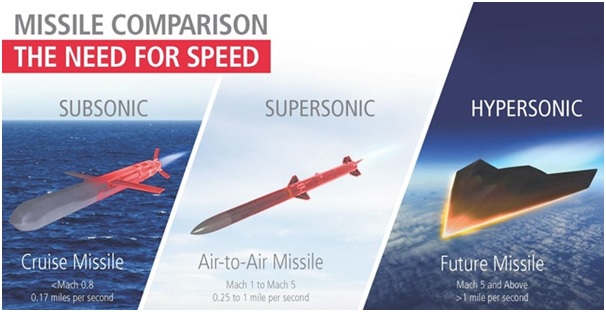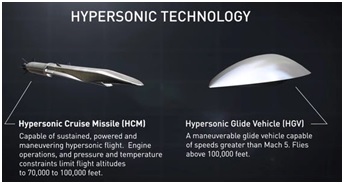Context
Though the hypersonic missile used by Russia against Ukraine is not particularly advanced. However, next-generation hypersonic missiles that Russia, China and the US are developing pose a significant threat to national and global security.
What is hypersonic?
- Describing a vehicle as hypersonic means that it flies much faster than the speed of sound, which is 1,225 kmph at sea level and 1,067 kmph at 35,000 feet where passenger jets fly.
- Passenger jets travel at just under 966 kmph, whereas hypersonic systems operate at speeds of 5,633 kmph – about 1.6 km per second – and higher.
- All of the intercontinental ballistic missiles in the world’s nuclear arsenals are hypersonic, reaching about 24,140 kmph, or about 6.4 km per second at their maximum velocity.
- ICBMs are launched on large rockets and then fly on a predictable trajectory that takes them out of the atmosphere into space and then back into the atmosphere again.
- The new generation of hypersonic missiles fly very fast, but not as fast as ICBMs.
- They are launched on smaller rockets that keep them within the upper reaches of the atmosphere.

Three types of Hypersonic missiles
There are three different types of non-ICBM hypersonic weapons:
- Hypersonic aero-ballistic system: A hypersonic aero-ballistic system is dropped from an aircraft, accelerated to hypersonic speed using a rocket and then follows a ballistic, meaning unpowered, trajectory.
- The system Russian forces used to attack Ukraine, the Kinzhal, is an aero-ballistic missile. The technology has been around since about 1980.
- Hypersonic glide vehicle: A hypersonic glide vehicle is boosted on a rocket to high altitude and then glides to its target, maneuvering along the way.
- Examples of hypersonic glide vehicles include
- China’s Dongfeng-17
- Russia’s Avangard
- US Navy’s Conventional Prompt Strike system.
- Hypersonic cruise missile: A hypersonic cruise missile is boosted by a rocket to hypersonic speed and then uses an air-breathing engine called a scramjet to sustain that speed.
- Because they ingest air into their engines, hypersonic cruise missiles require smaller launch rockets than hypersonic glide vehicles, which means they can cost less and be launched from more places.
- Hypersonic cruise missiles are under development by China and the US.
- The US reportedly conducted a test flight of a scramjet hypersonic missile in March 2020.


